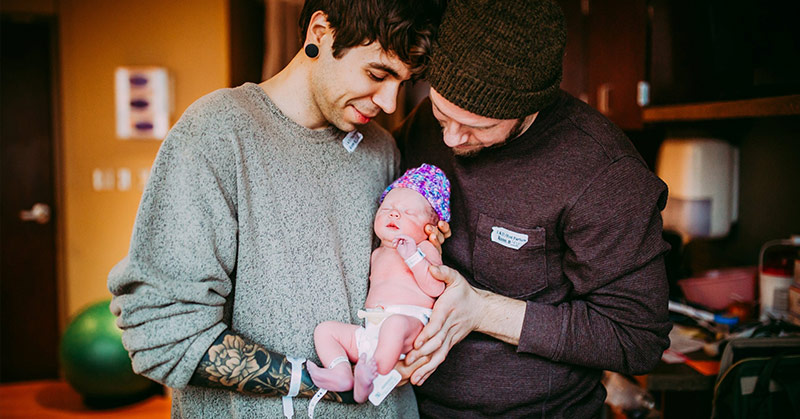“All the forces on this planet will never beat that of a mother’s love.” – Elle Smith
She didn’t actually believe it was possible that at the age of 60, she could go full-term as a gestational surrogate for her son and his partner. 61-year-old Cecile Eledge from Nebraska, Omaha, desperately wanted to be a grandmother. She jumped in head first when she was told there was nothing specifically stopping her from being a viable candidate for surrogacy.
Matthew Eledge, 32, and Elliot Dougherty, 29, were initially skeptical about being fathers. Matthew is a school teacher and Elliot is a hairdresser. They hadn’t exactly been thinking in the direction of surrogacy due to financial constraints. Fortunately for them, the costs were mitigated when their families stepped in to help. Matthew’s mother served as the surrogate, Elliot’s sister, Lea Yribe, donated the eggs, and Matthew donated the sperm. It was a journey that would forever remain in their hearts.
Sixty and Unafraid
Speaking to USA Today, Cecile said she had no doubts about what she was getting into [1]. “There was no moment of hesitation. It was natural instinct,” she said. The journey started when she was 60 years old. Long into menopause, she couldn’t provide eggs for the procedure. However, she passed her cardiovascular, cholesterol, and stress level tests. The doctors found her fit to withstand the hormone therapy that would precede the process.
She followed all their instructions, even kicking caffeine for nine solid months. Cecile was willing to do anything to ensure the safety of her grandchild.
“I would have felt terrible if anything had happened,” she said. “I followed things to the letter. You know, I love my coffee.” She had to get her body ready for the journey by getting physically fit and in shape. She’s definitely one of the oldest surrogate mothers in the world.
The risks of late pregnancy are many. Some of them include the increased chance of having a congenitally abnormal child, pre-eclampsia, miscarriage, high blood pressure, and increased risk of complication during delivery.
Yes, Grandma knew the risks.
Ray of Sunshine
Two loving dads, a doting grandmother, and a proud aunt were created on March 25, 2019, at the Nebraska Medical Center. Weighing 5 pounds and 13 ounces, Uma Louise Dougherty-Eledge was brought into this world. The fussy pink bundle of joy has been receiving so much attention, love, and adoration form her family, friends, and anyone who sets eyes upon her.
Speaking on the legalities and litigation that usually follow surrogacy procedures, Matthew said that for now, none of that is consequential.
“We are thankful with how the whole process worked,” Matthew Eledge said. “We are really grateful that both Uma and her grandma are here, happy and healthy. For the time being, we’re just going to relax and enjoy this moment.”
“We also believe it takes a village to raise a family,” he said. “While we may have taken an unconventional approach, we were able to talk about the process and it made everything more exciting and more fun.”
Unable to contain his joy, proud dad Elliot said: “I can’t believe tomorrow will be a week. She’s going to be a week old! The whole thing has just been amazing.”
Quick Information on Surrogacy
Surrogacy involves gestating an embryo in a uterus outside of the mother’s own [3]. In this case, the actual mother is Lea Yribe (Elliot’s sister), the egg donor, and Mathew (the sperm donor) is the biological father. The baby was gestated in Uma’s grandmother’s womb. The procedure is usually used by women who have serious uterine issues and infertility problems, severe fibromyalgia, hysterectomy, Mayer-Rokitansky-Küster-Hauser Syndrome (MRKH – the total absence of the uterus and vagina), and pre-existing health conditions [4]. As you can be seen from this case, same-sex couples can also use surrogacy to become parents.
There are two main kinds of surrogacy: Host/gestational surrogacy which involves fertilization of the intended mother’s egg with the intended father’s sperm and implanting the embryo in a host uterus, and straight surrogacy which involves the father’s sperm and the other woman’s egg, to be gestated in the other woman’s womb.
The family engaged in a host surrogacy procedure because the eggs were sourced outside their of the carrier, and the child is not (usually) biologically related to the gestational carrier. However, in this case, there is an obvious exception.
The baby is conceived through In-vitro fertilization (IVF). Following the egg extraction and insemination, the fertilized embryos would be transferred to the host uterus where implantation is expected to occur three to six days later. It may not always happen at the first attempt.
Surrogacy has helped many couples and even individuals become happy parents. The number of babies born through gestational surrogacy in the US increased by 89% from 2013 to 2017 [5]. US IVF clinics have a success rate of 75% in surrogate births [6].

